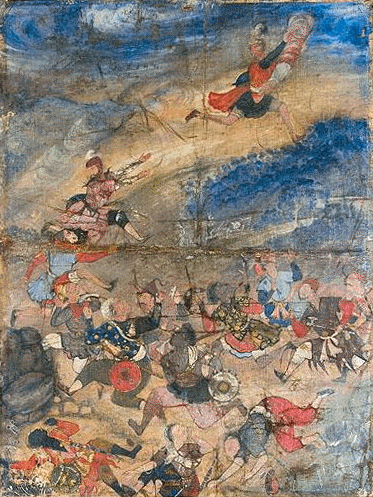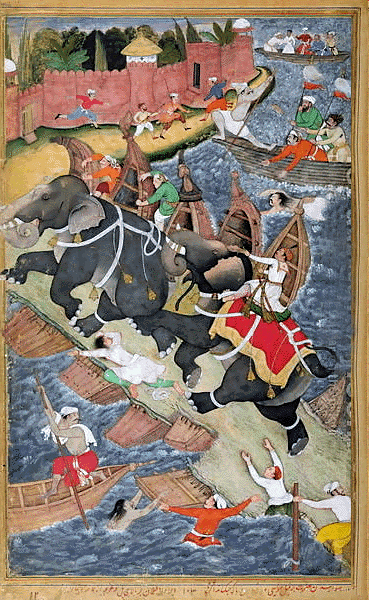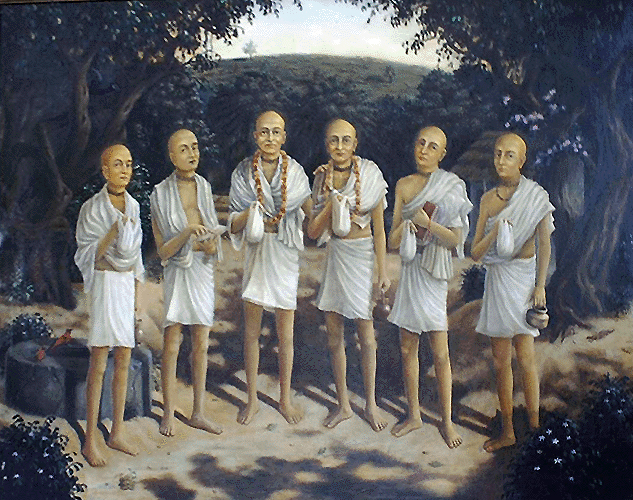
|
|
|
|
BY: SUN STAFF

Battle scene from Akbar's 'Hamza Nama' May 31, 2010 — CANADA (SUN) — A serial presentation of the Mughal effect on Vaisnava society. Although Emperor Akbar is considered by many today to have been the most benevolent of the early Mughal rulers, his military executed the same sort of campaign to destroy Vedic culture as his predecessors and successors did. With Babur and Humayun having paved the way, and following his own early successes in overpowering important Hindu strongholds, by the middle of Akbar's reign, his court was secure and comfortable enough to have grown into a somewhat bloated bureaucracy. With his power relatively unchallenged, Akbar was free to put into place various social programs to placate his Hindu subjects, and history seems to have significantly skewed in this direction in this regard.
Akbar's policies for reconciliation and assimilation of Hindus were instituted at every level of society: political, cultural, and religious. The mother of his son and eventual successor, Jahangir, was herself a Hindu Rajput. She was known to have influenced some of his decisions in developing a mood of cooperation with the local Indian citizens. Many Hindus skilled in administration were given jobs in Akbar's government, and Hindu chiefs were wooed into accepting positions as high-ranking members of his court. Akbar's government abolished the jizya (poll tax) that was a great burden to the people. At the social level, he encouraged intermarriage between members of the Mughal and Rajput aristocracy. He also encouraged re-marriage for widows, discouraged child marriages, and outlawed the practice of sati, all of which brought him favour with local residents.

Akbar tames the Savage Elephant, Hawa'I at Red Fort Akbar was a follower of the Sufi saint, Salim Chishti, a holy man who lived in the region of Sikri near Agra. Under Salim Chishti's influence, Akbar developed his own personal philosophy for integrating spiritual principles with rulership, and he considered his own reign to be a 'divine illumination'. This philosophy he enshrined in his new religion, Din-i-Ilahi (Divine Faith), which incorporated the principle of acceptance of all religions and sects. Of course, this period of 'enlightenment' is rather incongruous when held up to the years of violence perpetrated against Hindus and the destruction of their temples. Nonetheless, Akbar eventually became a supporter of Hindu religious life. The period of his rule, from 1556 to 1605 A.D., coincided with the pastimes of the Six Goswamis who, having follow Lord Caitanya's orders, had gone to Vrindaban to write. Just two years after Akbar came into power, in 1558 A.D., Sri Jiva Goswami purchased the land at Seva Kunj. Sanatana Goswami disappeared that same year, and Sri Rupa Goswami disappeared six years later. By this time, the fame of the Six Goswamis had spread far and wide, and in 1570, Emperor Akbar came to Vrindavan to meet the famous Jiva Goswami, who led the Mughal leader blindfolded into the sacred kunja at Nidhuvana. So moved was Akbar by this experience that he gave permission for the construction of four great temples of Sri Krsna: the temples of Govindaji, Gopinatha, Madana-mohana and Jugal-kisore. "Those who have gone to Vrndavana, they have seen the temple of Radha-Madana-mohana. That was established by Sanatana Gosvami, the first disciple of Lord Caitanya Mahaprabhu. Sanatana Gosvami established this Madana-mohana temple, and Rupa Gosvami established that Govindaji's temple, and the Jiva Gosvami established Radha-Damodara temple. Gopal Bhatta Gosvami established Radha-Ramana temple. In this way, in Vrndavana there are seven temples authorizedly established by the Gaudiya-sampradaya, Caitanya Mahaprabhu's sampradaya. Later on, many big, big kings and zamindars, landlords, they also established many temples, big, big temples. And altogether, there are five thousand temples in a small city like Vrndavana, and thousands of men go to see the Deities in every temple almost every day, and especially during the four months Sravana, Bhadra, Asvina, Karttika: July, in July, August, September, October. So Vrndavana is always crowded by many pilgrims, and anyone who goes there, immediately he feels spiritual consciousness, especially nowadays."
Akbar made available a quantity of first class sandstone for the Vrindavan temple projects. He also provided funds to establish a library for the preservation of the Six Gosvamis' literature at the Radha-Damodara temple. This original library was in the room to the left of the altar, and is known today as the grantha ghar, or book house.

The Six Goswamis By 1608 A.D., just three years after Akbar's death, Sri Jiva Goswami disappeared, following the disappearance of Sri Raghunatha das Goswami (d. 1571), Sri Gopal Bhatta Goswami (d. 1578), and Sri Raghunatha Bhatta Goswami (d. 1579). Sadly, in 1670 A.D., the demon Aurangzeb came through Vrindavan and destroyed many temples. Some of the Deities were moved to safety, spirited off to safe abodes like Jaipur, Nathdwar and Karoli in neighboring Rajasthan. Although Emperor Akbar no doubt absolved himself of some of his sinful activities by dedicating a portion of his treasury to the building of Sri Krsna's temples in Vrindavan, he still died a violent death, at the hands of his eldest son, Jahangir. Known as the "World Seizer", Jahangir and his wife Nur Jahan drove the Persian influence further into India, but mostly in the form of constructing their own opulent court facilities. They did little to further the Mughal Empire itself, and eventually, Jahangir met the same fate he had meted out to his father Akbar – he was killed by his own eldest son, Shah Jahan. Such is the legacy of ruination that comes from destroying those things belonging to Lord Sri Krsna.
| |